Notes
- ↑ "Rusky Castle". CANMORE . Royal Commission on the Ancient and Historical Monuments of Scotland . Retrieved 7 January 2017.
| This article about a Scottish castle is a stub. You can help Wikipedia by expanding it. |
| Rusky CastleRuskie Castle | |
|---|---|
| Loch Rusky, Scotland | |
| Coordinates | 56°12′10″N4°14′6″W / 56.20278°N 4.23500°W Coordinates: 56°12′10″N4°14′6″W / 56.20278°N 4.23500°W |
| Site information | |
| Condition | Ruin |
Rusky Castle, also known as Ruskie Castle, is a ruined castle on an islet on Loch Rusky, Stirling, Scotland. The islet is now submerged. [1] The castle was known to be held by Sir John de Menteith.
| This article about a Scottish castle is a stub. You can help Wikipedia by expanding it. |

A crannog is typically a partially or entirely artificial island, usually built in lakes, rivers, and estuarine waters of Scotland, Wales, and Ireland. Unlike the prehistoric pile dwellings around the Alps that were built on the shores and were inundated only later on, crannogs were built in the water, thus forming artificial islands.
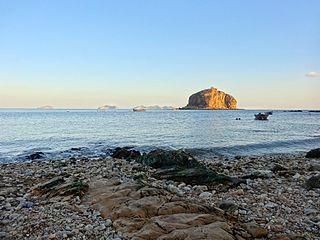
An islet is a very small island.

The Stirling council area is one of the 32 council areas of Scotland, and has a population of about 94,330. It was created under the Local Government etc (Scotland) Act 1994 with the boundaries of the Stirling district of the former Central local government region, and it covers most of Stirlingshire and the south-western portion of Perthshire. Both counties were abolished for local government purposes under the Local Government (Scotland) Act 1973.

Castle Stalker is a four-storey tower house or keep picturesquely set on a tidal islet on Loch Laich, an inlet off Loch Linnhe. It is about 1.5 miles (2.4 km) north-east of Port Appin, Argyll, Scotland, and is visible from the A828 road about midway between Oban and Glen Coe. The islet is accessible from the shore at low tide. The name "Stalker" comes from the Gaelic Stalcaire, meaning "hunter" or "falconer". The island castle is one of the best-preserved medieval tower-houses to survive in western Scotland and is a Category A listed building. It stands in the Lynn of Lorn National Scenic Area, one of forty such areas in Scotland.

Frederiksborg Castle is a palatial complex in Hillerød, Denmark. It was built as a royal residence for King Christian IV of Denmark-Norway in the early 17th century, replacing an older castle acquired by Frederick II and becoming the largest Renaissance residence in Scandinavia. Situated on three islets in the Slotssøen, it is adjoined by a large formal garden in the Baroque style.
The Cumbraes are a group of islands in the Firth of Clyde, Scotland. The islands belong to the traditional county of Bute and the modern unitary authority of North Ayrshire.
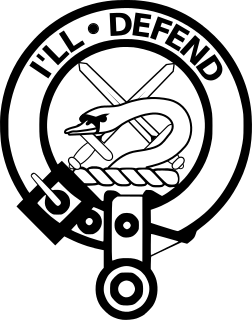
Clan Lennox is a Lowland Scottish clan. The clan chiefs were the original Earls of Lennox, although this title went via an heiress to other noble families in the fifteenth and sixteenth centuries. The chiefship of the clan then went to the Lennox of Woodehead branch.
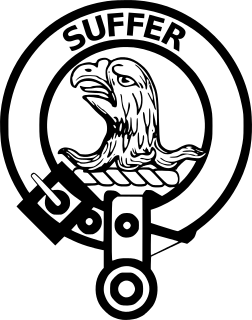
Clan Haldane is a Lowland Scottish clan.

The Castelli di Cannero are three rocky islets of Lake Maggiore in northern Italy. They are located off the shoreline of Cannero Riviera while administratively forming part of the Comune of Cannobio. They are known as castelli, or castles, in recognition of the ruined ancient fortifications which are found on two of them.

Loch Kinord is a small, freshwater loch at Muir of Dinnet, Aberdeenshire, Scotland just north of the River Dee and 5 mi (8.0 km) east of Ballater. The loch is also known as Loch Ceander and Loch Cannor. It is approximately 1 mi (1.6 km) in length and was formed from a glacial kettle hole. The loch sits within the Muir of Dinnet National Nature Reserve and is immediately south of Loch Davan.

Inchgalbraith is an islet in Loch Lomond, Scotland, and is the ancestral home of Clan Galbraith.

Loch Rusky is a small freshwater loch near Callander in the Stirling council area in Scottish Highlands.
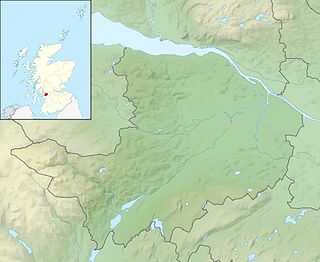
Renfrew Castle was situated at the royal burgh of Renfrew, Scotland, which is near the confluence of the River Clyde and the River Cart. The original 12th-century castle was built by Walter fitz Alan, Steward of Scotland, upon a river islet known as the King's Inch. This was replaced in the 13th century with a new castle by the road to the Clyde ferry, which became a royal castle under King Robert II. In the 15th century, the King's Inch site was rebuilt as Inch Castle by Sir John Ross. Both castles were demolished in the 18th century and nothing remains above ground at either site.

Loch of Avich is a large freshwater loch that lies approximately 1 mi (1.6 km) west of Loch Awe in Argyll and Bute in Scotland. It is the second biggest loch in the Etive basin after Loch Awe. It trends east-northeast, west-southwest and is narrowly triangular in shape. At the southwest end of the loch is the islet Innis Luana on which stands the ruins of an ancient castle named Caisteal na Nighinn Ruaidhe. The castle may have been the original seat of Clan Campbell. Near the north shore on the islet of Eilean Fraoch is the remains of a crannog.
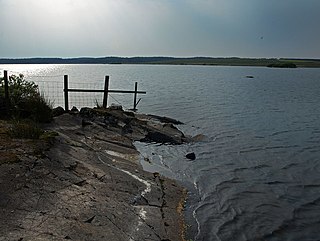
Castle Loch is a shallow eutrophic loch covering an area of around 100 hectares in the town of Lochmaben in Dumfries and Galloway, Scotland. It lies to the west of Mochrum Loch and has 2 islets. The ruined Lochmaben Castle lies at the southern end of the loch.